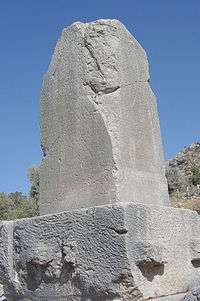Lycian language
| Lycian | |
|---|---|
| 𐊗𐊕𐊐𐊎𐊆𐊍𐊆 Trm̃mili | |
|
Xanthos stele with Lycian inscriptions | |
| Native to | Lycia, Lycaonia |
| Region | Southwestern Anatolia |
| Era | 500 – ca. 200 BCE[1] |
| Lycian script | |
| Language codes | |
| ISO 639-3 |
xlc |
Linguist list |
xlc |
| Glottolog |
lyci1241[2] |
The Lycian language (𐊗𐊕𐊐𐊎𐊆𐊍𐊆 Trm̃mili)[3] was the language of the ancient Lycians of the region known as Lycia in Anatolia (present day Turkey), during the Iron Age.
Area
Lycia covered the region lying between the modern cities of Antalya and Fethiye in southern Turkey, especially the mountainous headland between Fethiye Bay and the Gulf of Antalya. The Lukka, as they were referred to in ancient Egyptian sources, which mention them among the Sea Peoples, probably also inhabited the region called Lycaonia, located along the next headland to the east, also mountainous, between the modern cities of Antalya and Mersin.
Classification
Lycian was an Indo-European language, one in the Luwian subgroup of Anatolian languages. The Luwian subgroup also includes cuneiform and hieroglyphic Luwian, Carian, Sidetic, and Pisidic.[4] The pre-alphabetic forms of Luwian extended back into the Late Bronze Age and preceded the fall of the Hittite Empire. These vanished at about the time of the Neo-Hittite states in southern Anatolia (and Syria); thus, the Iron Age members of the subgroup are localized daughter languages of Luwian.
Of the Luwic languages, only the Luwian parent language is attested prior to 1000 BCE, so it is unknown when the classical-era dialects diverged. Whether the Lukka people always resided in southern Anatolia or whether they always spoke Luwian are different topics.
Lycian is known from a few fairly extensive inscriptions. From them, scholars have identified at least two dialects. One is considered standard Lycian, also termed Lycian A; the other, which is attested on side D of the Xanthos stele, is termed Lycian B or Milyan, separated by its grammatical particularities. Lycian had its own alphabet, which was closely related to the Greek alphabet but included at least one character borrowed from Carian as well as characters proper to the language. The words were often separated by two points.
Lycian became extinct around the beginning of the first century BC, replaced by the Ancient Greek language.
Endonym

A few etymological studies of the Lycian language endonym are present. These are:[3]
- Language of the mountain people (LaRoche). Luwian tarmi- "pointed object" becomes a hypothetical *tarmašši- "mountainous" used in Trm̃mis- "Lycia." Lycia and Pisidia each had a hill-town named Termessos.
- Attarima (Carruba). A previously unknown Late Bronze Age place name among the Lukka.
- Termilae (Bryce). A people displaced from Crete about 1600 BC.
- Termera (Strabo[5]) A Lelege people displaced by the Trojan War, first settling in Caria and assigning such names as Telmessos, Termera, Termerion, Termeros, Termilae, then displaced to Lycia by the Ionians.[6]
Sources
Lycian is known from these sources:[7][8]
- Personal and place names in Greek.
- 172 inscriptions on stone in the Lycian script dating from the late 5th century BC to the late 4th century BC.[9] They are categorized as:
- 150 burial instructions carved on rock tombs.
- 20 votive or dedicatory inscriptions.
- About 100 inscriptions on coins minted at Xanthus from the reign of Kuprili, 485-440 BC, to the reign of Pericle, 380-360 BC.[10]
- The Letoon trilingual, in Lycian A, Greek and Aramaic.
- The Xanthus stele bilingual. The inscribed upper part of a tomb at Xanthos, called the Xanthus Stele or the Xanthus Obelisk. A Lycian A inscription covers the south, east and part of the north faces. The north side also contains a 12-line poem in Greek and additional text, found mainly on the west side, in a dialect of Lycian called Milyan or Lycian B. The dialect appears only there and on a tomb in Antiphellos. The total number of lines on the stele is 255, including 243 in Lycian and 12 in Greek.
The inscriptional material covers a time span of about 170 years, between 500-330 BC.[11]
Description
A number of principal features help identify Lycian as being in the Luwian group:[12]
- Assibilation of Indo-European (IE) palatals (Satem change): *h₁éḱwos to Luwian á-zú-wa/i-, Lycian esbe, "horse."
- Replacement of genitive case with adjectives ending in -ahi or -ehi, Luwian -assi-.
- A preterite active formed with Indo-European secondary middle endings:
- IE *-to Luwian -ta, Lycian te- or de- in the third person singular
- IE *-nto to Luwian -nta, Lycian (n)te in the third person plural
- Similarity of words: Luwian māssan(i)-, Lycian māhān(i), "god."
Notes
- ↑ Lycian at MultiTree on the Linguist List
- ↑ Hammarström, Harald; Forkel, Robert; Haspelmath, Martin; Bank, Sebastian, eds. (2016). "Lycian". Glottolog 2.7. Jena: Max Planck Institute for the Science of Human History.
- 1 2 Bryce (1986) page 30.
- ↑ Adiego (2007) page 763.
- ↑ Strabo 7.7.1, 13.1.59.
- ↑ Strabo 14.1.3, 14.2.18.
- ↑ Adiego (2007) page 764.
- ↑ Bryce (1986) page 42.
- ↑ Bryce (1986) page 50.
- ↑ Bryce (1986) pages 51–52.
- ↑ Bryce (1986) page 54.
- ↑ Adiego (2007) page 765.
See also
External links
References
- Adiego, I.J. (2007). "Greek and Lycian". In Christidis, A.F.; Arapopoulou, Maria; Chriti, Maria. A History of Ancient Greek From the Beginning to Late Antiquity. Chris Markham (trans.). Cambridge University press. ISBN 0-521-83307-8.. Translator Chris Markham.
- Bryce, Trevor R. (1986). The Lycians - Volume I: The Lycians in Literary and Epigraphic Sources. Copenhagen: Museum Tusculanum Press. ISBN 87-7289-023-1.
